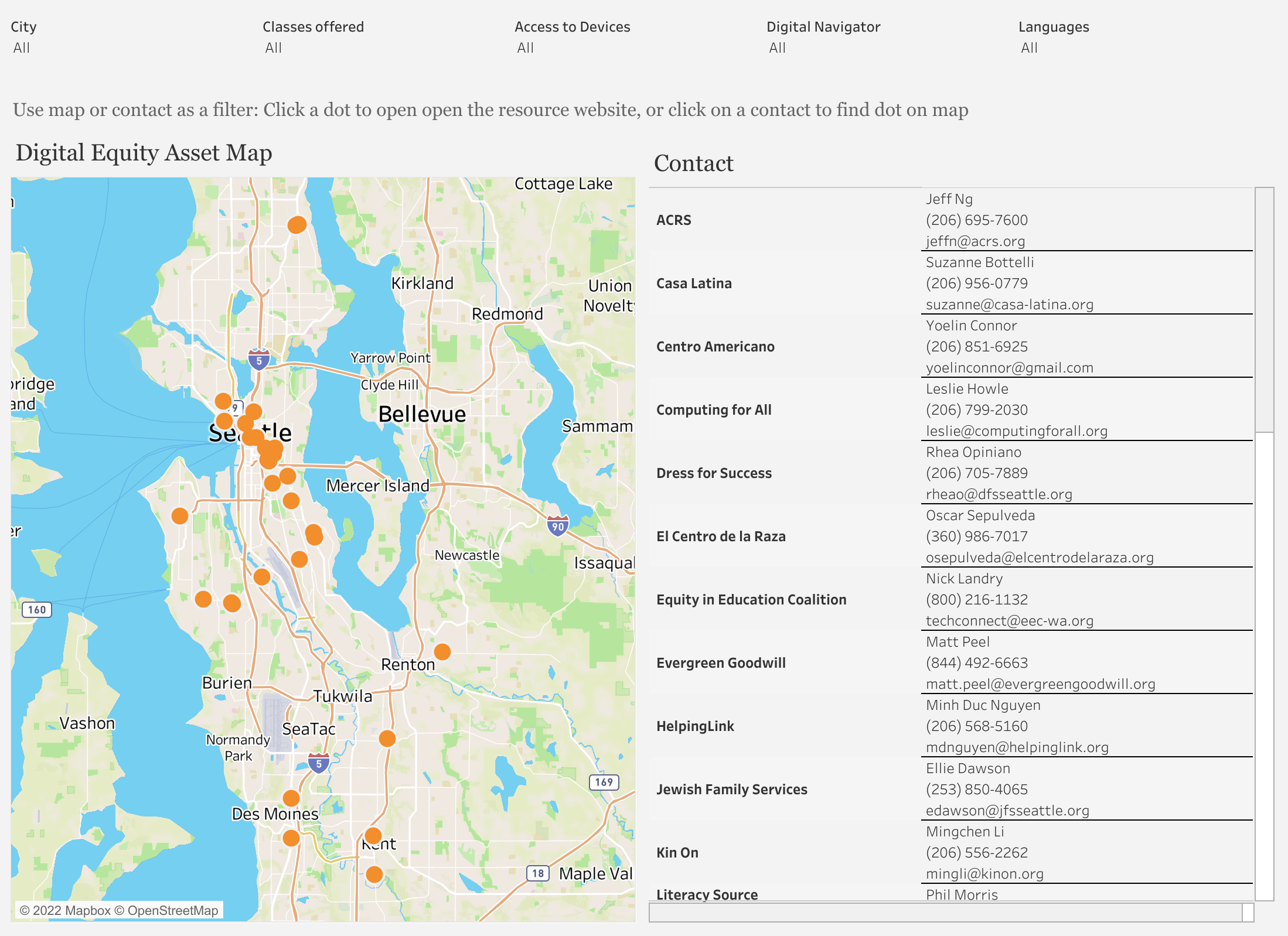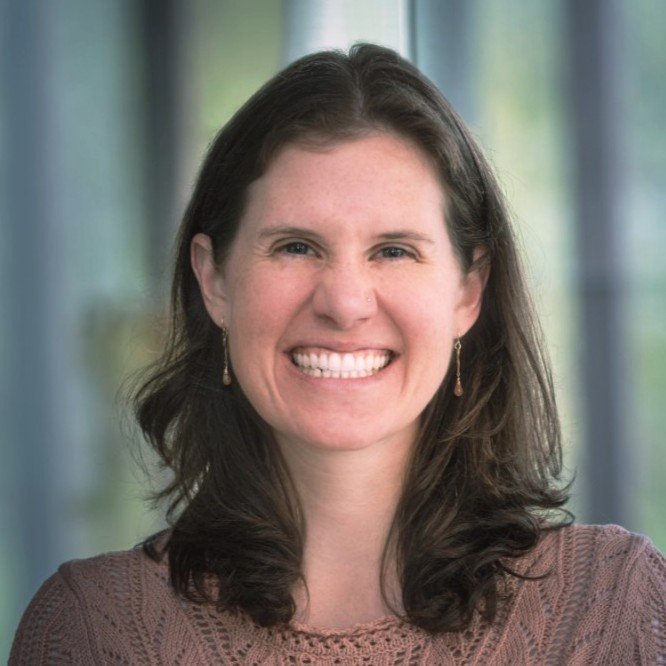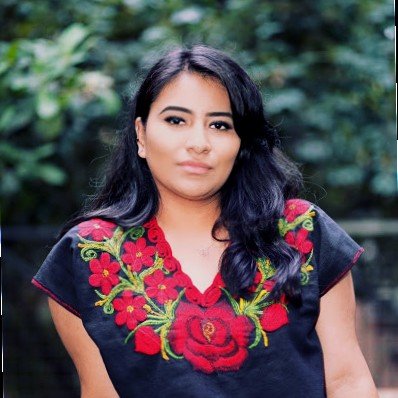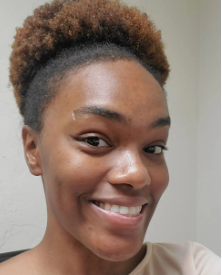Marisol Tapia Hopper
Project Manager, Workforce Development Council of Seattle-King County
Interview by Xuan Bui & Yousef Sayed
November 15, 2022
Marisol Tapia Hopper is the Project Manager at the Workforce Development Council of Seattle-King County. Marisol is passionate about advocacy and working collaboratively to advance digital inclusion with the goal to make the change, engage in policy, and change systems. Her organization just launched the Digital Equity Asset Map that tracks and locates digital equity resources in King County.
Q. What is your definition of Digital Equity, and what about it motivates you?
MTH: My vision of Digital Equity is about making sure that when we talk about Digital Equity, we are being intentional in creating policies, programs, and services that help ensure every person, particularly communities that have been disproportionately impacted by the digital divide, have access to devices, foundation digital skills, and high quality, high-speed internet to fully participate in society. To me, it boils down to creating that intentionality behind inclusion and making sure that people have the technology and resources they need to thrive and participate.
I am motivated by the desire to make the change, engage in policy, and change systems. I am passionate about advocacy and working collaboratively to advance digital inclusion in our region, state, and our country. Thinking largely about how we all advance this work collectively and the opportunity to meet with other practitioners and service providers; listen to people's stories and use that information and their voice at the table to drive systems to change.
Q. What values and/or principles are important for everyone in this space to do good work?
MTH: I would say collaboration is key for doing this work. We cannot be doing this work in silos. We really need to be coordinating and aligning our work, so organizations are talking to each other, and collaborating to advance systems change. That's a big driver for us at the WDC, really making sure that we are aligning resources, but also making sure that we're collaborating and bringing stakeholders to the table, and really embedding racial equity within our work and customer voice within our processes.
“We cannot be doing this work in silos. We really need to be making sure we are embedding racial equity within our work and customer voice within our processes.”
Q. What have been big wins for you and how did they happen? What sorts of support were needed for them?
MTH: We launched the Digital Needs Assessment Tool in August, as part of a larger effort to standardize the process for assessing the digital needs of job seekers in our programs. We worked collaboratively with front-line staff to create this tool which is now part of the intake process in our Workforce Innovation & Opportunity Act (WIOA) programming. By assessing the digital needs of participants, case managers are also able to connect individuals to needed resources, such as computers and digital skills classes. And as a result, we are more proactive in our approach to embedding digital equity goals within workforce development. So this has been a big win. Three months ago, we launched the Digital Equity Asset Map. This was done in collaboration with digital equity advocates as part of an effort to identify all the digital equity resources in the Seattle-King County region.
Q. What sorts of support were needed for them?
MTH: I would say finding people that have the same commitment and passion for this work. Luckily I've been working with so many great people in this field that are deeply connected to this work and care about it as well. I think the key to success in this work is finding people that deeply want to advance racial equity, and are willing to go the extra mile to get the work done. We have many great leaders in our region and I feel extremely grateful that I get to work in partnership with great colleagues.
Q. What is your organization’s goal in moving towards digital equity? What steps are being made by your organization to reach that vision?
MTH: Definitely bring the funding that our region needs to fully support a digital equity strategy where organizations can fully fund digital navigators, and have robust access to devices, the internet, and digital skills programming. So when someone in the community doesn't have a device, organizations have the resources to help communities acquire one and offer the technical support to learn how to use it. In our community, we have programs that are teaching digital skills in multiple languages and have dedicated staff that could help individuals access technology.
Another goal is expanding collaboration, and thinking collectively about how we can create systemic change by partnering, collaborating, and aligning our resources and expertise. This means working with the county, the city of Seattle, Seattle Public Library, and the State Broadband Office to advance a shared digital equity strategy and goals.
Q. What’s an example of some good work so far and who’s been doing it? Who would you like to give a shout-out to?
MTH: There's been so much good work. There's just so much happening. I just gave you a couple of examples of things that I've done. Goodwill is doing some good work with their own digital navigator pilot that they have and their device distribution program. We have many community-based organizations (see the map) that are doing amazing work helping people get connected to not only digital skills classes but access to devices. Casa Latina is doing great work teaching digital skills in Spanish. Likewise, Villa Comunitaria has a great program Aula Digital en Accion (Digital Classroom in Action). We have the Somali Family Safety Taskforce that is providing digital skills classes in Somali. We have so many organizations that are doing really amazing work. There are many great examples out there.
Learn more about Workforce Development Council of Seattle-King County (WDC)
Learn more about Workforce Innovation & Opportunity Act (WIOA)
Connect with Marisol Tapia on LinkedIn.






